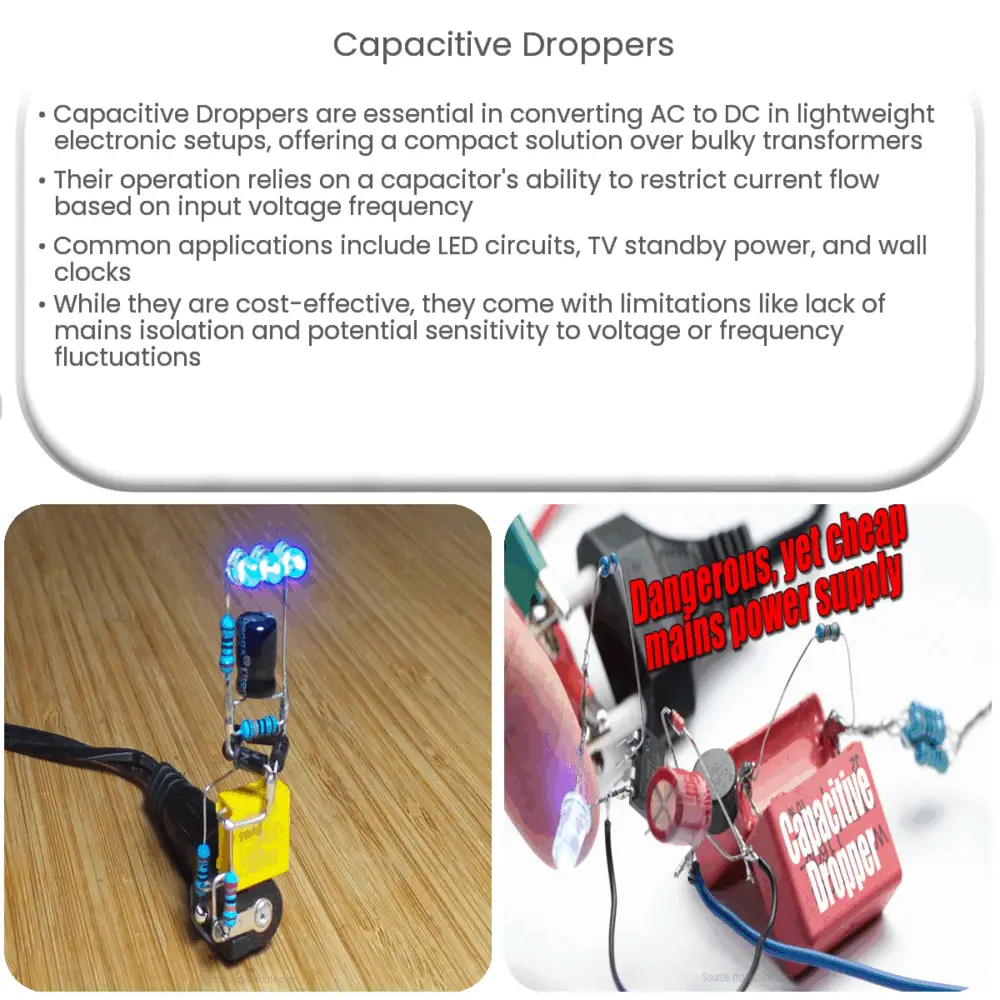Explore the fundamentals of capacitive droppers, their operation, design, applications, limitations, and advancements in electronics.

Introduction to Capacitive Droppers
A Capacitive Dropper is a critical component found in electronics, often utilized in AC to DC power supplies. It performs the essential task of reducing the voltage in a system, primarily in situations where the load is light and a transformer would be excessively bulky or expensive.
Operating Principle of Capacitive Droppers
The working principle of a capacitive dropper is rooted in the inherent properties of a capacitor. Essentially, a capacitor has the unique capability to impede the flow of current based on the frequency of the input voltage. In an AC circuit, the reactance of the capacitor is inversely proportional to the frequency. Therefore, a higher frequency implies lower impedance and vice versa.
Components of a Capacitive Dropper
- Capacitor: This is the main component of the capacitive dropper. Its purpose is to limit the current flow and drop the voltage to the required level.
- Rectifier: Usually, a full-wave rectifier is employed to convert the AC signal into a DC signal after the voltage drop.
- Resistor: A bleed resistor is included in parallel with the capacitor. It discharges the capacitor when the supply is disconnected, preventing any potential electric shock.
Applications of Capacitive Droppers
Capacitive droppers are generally used in low-power electronic devices. Their most common application is in power supplies for electronic devices, such as:
- LED lighting circuits
- Standby power for televisions and computer monitors
- Wall clocks
Pitfalls and Safety Considerations
While capacitive droppers offer several advantages, they also come with significant drawbacks that must be considered. Their primary limitation is the lack of isolation from the mains supply, making them unsuitable for high power applications. Additionally, a capacitive dropper’s performance can be significantly affected by fluctuations in the input frequency or voltage, potentially damaging the device it is supplying power to.
Conclusion
In the world of electronics, capacitive droppers play a crucial role in managing the power supply for various devices. They are a testament to the ingenuity of electronic design, enabling cost-effective and compact power solutions. However, understanding their limitations and proper usage is just as vital to ensure the safe and efficient operation of electronic devices.
Designing a Capacitive Dropper
The design of a capacitive dropper requires careful consideration of several factors. First, the value of the capacitor is critical, as it determines the amount of current that the dropper can handle. The capacitor must be sized appropriately for the specific application to avoid overheating and possible failure.
Second, the choice of the rectifier is also essential. It must have a sufficiently high voltage rating to handle the peak voltages, and its current rating must be adequate for the load. Usually, a silicon diode is used due to its robustness and efficiency.
Fundamental Limitations
Despite their utility, capacitive droppers are not suitable for every application. Their most notable limitation is that they cannot supply large amounts of power. This is because the capacitive reactance decreases as the load increases, which leads to a higher current flow and thus more heat generation. Additionally, they lack isolation from the mains supply, which could pose a safety risk in certain scenarios.
Advancements in Capacitive Droppers
While traditional capacitive droppers have their limitations, advancements in technology have led to improved designs. Modern capacitive droppers often incorporate additional components such as Zener diodes and linear regulators to maintain a stable output voltage despite fluctuations in the input. They may also include safety features such as fuses and circuit breakers to protect against overcurrent conditions.
Conclusion
Capacitive droppers have proven to be an essential tool in the realm of electronics, particularly for low-power devices. They offer a cost-effective, compact alternative to bulky transformers, making them ideal for small, portable devices. Despite their limitations, the continued evolution of capacitive dropper design points towards even greater utility in the future. As technology continues to miniaturize, the demand for small, efficient power solutions like capacitive droppers is set to rise.
When employing a capacitive dropper, it is vital to understand the nature of the device and its limitations. Understanding the theory behind its operation, safety considerations, and design aspects will ensure its effective use. With this knowledge, one can harness the benefits of capacitive droppers while mitigating potential risks, contributing to the development of efficient, safe, and compact electronic devices.

